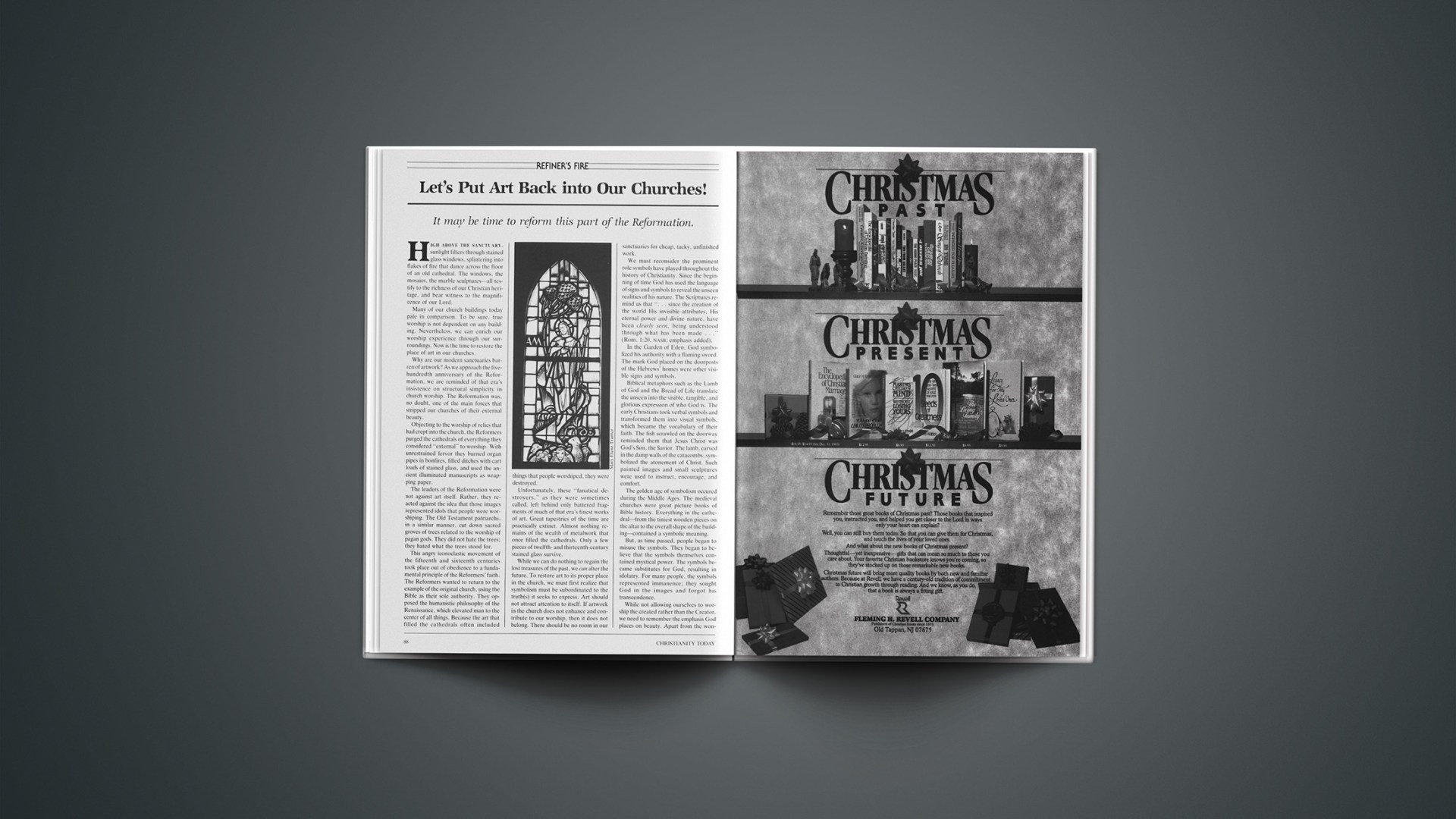It may be time to reform this part of the Reformation.
High above the sanctuary, sunlight filters through stained glass windows, splintering into flakes of fire that dance across the floor of an old cathedral. The windows, the mosaics, the marble sculptures—all testify to the richness of our Christian heritage, and bear witness to the magnificence of our Lord.
Many of our church buildings today pale in comparison. To be sure, true worship is not dependent on any building. Nevertheless, we can enrich our worship experience through our surroundings. Now is the time to restore the place of art in our churches.
Why are our modern sanctuaries barren of artwork? As we approach the five-hundredth anniversary of the Reformation, we are reminded of that era’s insistence on structural simplicity in church worship. The Reformation was, no doubt, one of the main forces that stripped our churches of their external beauty.
Objecting to the worship of relics that had crept into the church, the Reformers purged the cathedrals of everything they considered “external” to worship. With unrestrained fervor they burned organ pipes in bonfires, filled ditches with cart loads of stained glass, and used the ancient illuminated manuscripts as wrapping paper.
The leaders of the Reformation were not against art itself. Rather, they reacted against the idea that those images represented idols that people were worshiping. The Old Testament patriarchs, in a similar manner, cut down sacred groves of trees related to the worship of pagan gods. They did not hate the trees; they hated what the trees stood for.
This angry iconoclastic movement of the fifteenth and sixteenth centuries took place out of obedience to a fundamental principle of the Reformers’ faith. The Reformers wanted to return to the example of the original church, using the Bible as their sole authority. They opposed the humanistic philosophy of the Renaissance, which elevated man to the center of all things. Because the art that filled the cathedrals often included things that people worshiped, they were destroyed.
Unfortunately, these “fanatical destroyers,” as they were sometimes called, left behind only battered fragments of much of that era’s finest works of art. Great tapestries of the time are practically extinct. Almost nothing remains of the wealth of metalwork that once filled the cathedrals. Only a few pieces of twelfth-and thirteenth-century stained glass survive.
While we can do nothing to regain the lost treasures of the past, we can alter the future. To restore art to its proper place in the church, we must first realize that symbolism must be subordinated to the truth(s) it seeks to express. Art should not attract attention to itself. If artwork in the church does not enhance and contribute to our worship, then it does not belong. There should be no room in our sanctuaries for cheap, tacky, unfinished work.
We must reconsider the prominent role symbols have played throughout the history of Christianity. Since the beginning of time God has used the language of signs and symbols to reveal the unseen realities of his nature. The Scriptures remind us that “… since the creation of the world His invisible attributes. His eternal power and divine nature, have been clearly seen, being understood through what has been made …” (Rom. 1:20, NASB; emphasis added).
In the Garden of Eden, God symbolized his authority with a flaming sword. The mark God placed on the doorposts of the Hebrews’ homes were other visible signs and symbols.
Biblical metaphors such as the Lamb of God and the Bread of Life translate the unseen into the visible, tangible, and glorious expression of who God is. The early Christians took verbal symbols and transformed them into visual symbols, which became the vocabulary of their faith. The fish scrawled on the doorway reminded them that Jesus Christ was God’s Son, the Savior. The lamb, carved in the damp walls of the catacombs, symbolized the atonement of Christ. Such painted images and small sculptures were used to instruct, encourage, and comfort.
The golden age of symbolism occured during the Middle Ages. The medieval churches were great picture books of Bible history. Everything in the cathedral—from the tiniest wooden pieces on the altar to the overall shape of the building—contained a symbolic meaning.
But, as time passed, people began to misuse the symbols. They began to believe that the symbols themselves contained mystical power. The symbols became substitutes for God, resulting in idolatry. For many people, the symbols represented immanence; they sought God in the images and forgot his transcendence.
While not allowing ourselves to worship the created rather than the Creator, we need to remember the emphasis God places on beauty. Apart from the wonders of his creation, we see specific instances where God ordained beauty and design as an essential part of worship. For instance, he demanded the finest materials and the most skilled craftsmen in the construction of the tabernacle of the Old Testament. Read Exodus 25–40 and try to imagine its exquisite beauty.
Perhaps with some knowledge of the craftsmanship of ancient Egyptians and Mesopotamians we can begin to realize the beauty and magnitude of the furnishings of the tabernacle. We can examine the treasure of the ancient Egyptian king Tutankhamen, for example. The construction of the ark of the covenant is described in Exodus 25:10–22: “And they shall construct an ark of acacia wood … and you shall overlay it with pure gold, inside and out …” (NASB). This is easily visualized when we compare it to Tutankhamen’s small shrine made of wood covered with sheets of gold, hammered with bands of inscriptions and decorative friezes.
The Levitical priests’ sacred garments were to be made of fine woven cloth, with precious stones mounted in gold filigree settings (Exod. 28:4–14). From ancient Egypt we have preserved examples of woven robes heavily embroidered with intricate beaded patterns.
Isaiah’s (Isa. 6) and Ezekiel’s (Ezek. 1) visions of the glories surrounding the throne of God almost defy description. In the Revelation of John of the kingdom of God we read of streets of gold, gates of pearl, and a river flowing from the throne, its banks lined with trees bearing 12 kinds of fruit. What imagery!
Through a study of Scripture and the history of the church, we can see how artwork expresses the nature of the great Creator. Let us make use of the respectable language of Christian art. Let us worship God with beauty, color, and design. Let us restore a sense of celebration to our worship experience.
Perhaps the Reformation’s insistence on external simplicity still haunts us. Or perhaps it is the temptation to worship art that worries us. In that case, it is our hearts that need to be purged, not our churches. Give us back beauty in our churches—we worship the King!
MARGE and STEPHEN GIESER1Mrs. Gieser, a graduate of the Art Institute of Chicago, creates seasonal banners, pulpit hangings, and altar cloths for churches. Her son Stephen was a writing intern with the U.S. Department of Health and Human Resources before enrolling as a medical student at the University of Illinois in Chicago.










